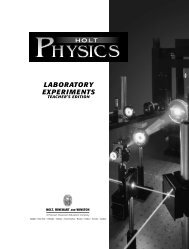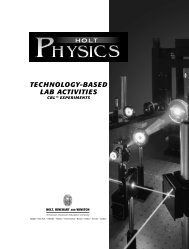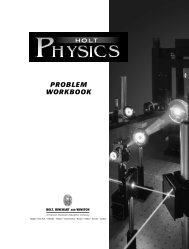LABORATORY EXPERIMENTS
LABORATORY EXPERIMENTS - Langlo Press - langlopress.net
LABORATORY EXPERIMENTS - Langlo Press - langlopress.net
- No tags were found...
You also want an ePaper? Increase the reach of your titles
YUMPU automatically turns print PDFs into web optimized ePapers that Google loves.
HOLT PHYSICS Sample Invention Lab Report continued<br />
series with the light bulb and the doormat provides<br />
a potential difference to the circuit. The<br />
doormat acts as a switch in this circuit. When the<br />
two surfaces of the doormat are not touching, as<br />
when no weight is applied to the doormat, the<br />
switch is open and there is no current in the circuit.<br />
When weight is applied to the doormat and<br />
the two foil-covered surfaces touch, the switch is<br />
closed and there is current in the circuit according<br />
to the potential difference and the resistance present<br />
in the circuit. This relationship is given by the<br />
following equation:<br />
I = ⎯ ∆ V ⎯<br />
R<br />
We developed our circuit using a 9 V dc battery<br />
and a 6.3 V, 115 mA light bulb.<br />
When there is current in the circuit, the light bulb,<br />
which acts as a resistor in the circuit, will light.<br />
When the weight is removed from the doormat,<br />
the plates of the doormat will separate, opening<br />
the switch, and there will be no current in the circuit.<br />
The light bulb will no longer be lighted.<br />
8. Conclusion, Ramifications, and Scope of<br />
Invention: The Doormat Lighting System is a<br />
security lighting device that uses a resistor in a dc<br />
circuit with a battery. The doormat itself operates<br />
as a switch in this circuit, and a light bulb operates<br />
as a resistor. When the doormat is stepped on, the<br />
switch is closed and the light bulb lights. When the<br />
weight is removed from the doormat, the switch is<br />
opened and the light stops.<br />
In this design, pieces of plastic drinking straws are<br />
used to separate the two conducting parts of the<br />
doormat. Other items, such as springs, may be<br />
used in place of the drinking straws. Any material<br />
used for this purpose must be flexible, so that it<br />
will compress when weight is applied and will<br />
return to its original position when the weight is<br />
removed, and it must not conduct electricity. In<br />
fact, another type of separator may be better,<br />
because the drinking straws become flattened with<br />
use and will need to be replaced often to maintain<br />
the required distance between the two pieces.<br />
The dimensions of all the parts of this system,<br />
from the size of the doormat to the length of the<br />
wires, depends upon the desired use. This system<br />
may be used to place a doormat outside the door<br />
of a house and light a lamp above the door, or it<br />
may be used to light a lamp placed inside the<br />
house or at another location. The battery and light<br />
bulb must be selected so that the battery provides<br />
enough potential difference to light the selected<br />
bulb but not enough to cause a fire or short<br />
circuit.<br />
Another possible use of the design would be to use<br />
a resistor other than a light bulb. For example, the<br />
circuit could contain a buzzer or some other<br />
device. In this way, the circuit could operate as an<br />
alarm system or a doorbell. In addition, the switch<br />
in the circuit could be designed for use in any<br />
device that required a pressure-sensitive switch.<br />
The switch could be placed in the bottom of a<br />
mailbox and wired to a light or buzzer inside the<br />
house; this system would notify someone inside<br />
the house that the mail had been delivered.<br />
Because aluminum foil conducts electricity, it<br />
would be necessary to cover the entire switch in<br />
insulating material before using this device.<br />
HRW material copyrighted under notice appearing earlier in this book.<br />
viii<br />
HOLT PHYSICS Laboratory Experiments





